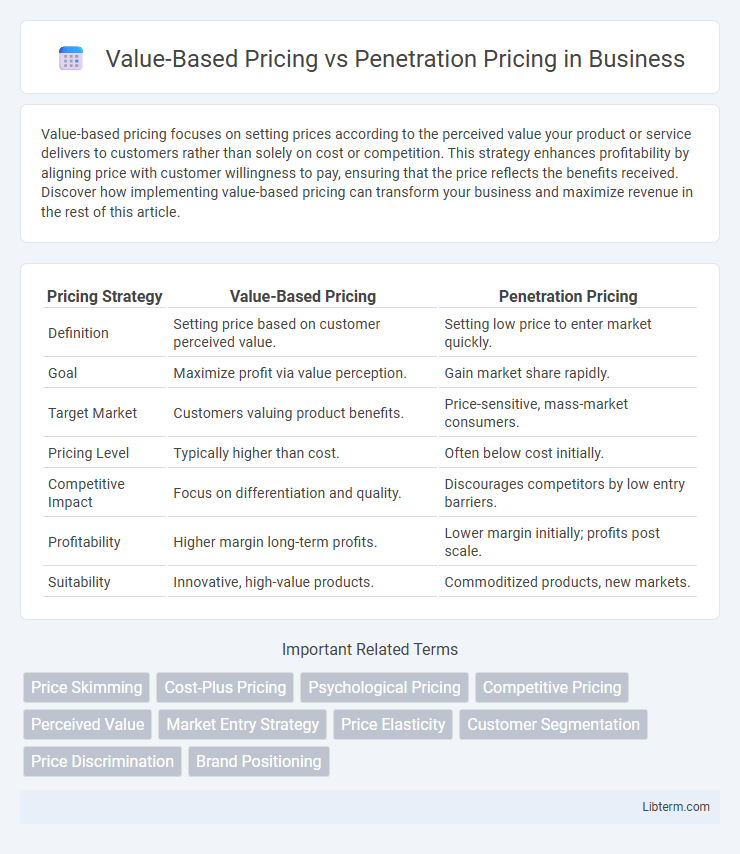Value-based pricing focuses on setting prices according to the perceived value your product or service delivers to customers rather than solely on cost or competition. This strategy enhances profitability by aligning price with customer willingness to pay, ensuring that the price reflects the benefits received. Discover how implementing value-based pricing can transform your business and maximize revenue in the rest of this article.
Table of Comparison
| Pricing Strategy | Value-Based Pricing | Penetration Pricing |
|---|---|---|
| Definition | Setting price based on customer perceived value. | Setting low price to enter market quickly. |
| Goal | Maximize profit via value perception. | Gain market share rapidly. |
| Target Market | Customers valuing product benefits. | Price-sensitive, mass-market consumers. |
| Pricing Level | Typically higher than cost. | Often below cost initially. |
| Competitive Impact | Focus on differentiation and quality. | Discourages competitors by low entry barriers. |
| Profitability | Higher margin long-term profits. | Lower margin initially; profits post scale. |
| Suitability | Innovative, high-value products. | Commoditized products, new markets. |
Introduction to Pricing Strategies
Value-Based Pricing sets product prices based on perceived customer value and willingness to pay, emphasizing customer benefits and unique selling points to maximize profit margins. Penetration Pricing introduces products at low prices to quickly attract market share and customer adoption, often sacrificing short-term profits for long-term growth. Selecting between these strategies depends on market dynamics, product differentiation, and competitive landscape.
What is Value-Based Pricing?
Value-Based Pricing is a strategy where prices are set primarily based on the perceived value to the customer rather than on the cost of the product or historical prices. This approach leverages customer insights and market research to determine how much a target segment is willing to pay, often resulting in higher profit margins for innovative or high-demand products. Companies using Value-Based Pricing prioritize delivering superior benefits and unique features that justify premium pricing aligned with customer expectations.
What is Penetration Pricing?
Penetration pricing is a marketing strategy where a product is introduced at a low price to quickly attract customers and gain market share. This approach aims to deter competitors and encourage widespread product adoption by offering significant initial value. Effective penetration pricing relies on high sales volume to offset lower profit margins and establish a strong market position.
Key Differences Between Value-Based and Penetration Pricing
Value-based pricing sets product prices according to perceived customer value, emphasizing benefits and unique features that justify higher costs, while penetration pricing starts with low prices to quickly capture market share and attract price-sensitive customers. Value-based pricing relies heavily on market research and customer insights to align with demand elasticity, whereas penetration pricing focuses on volume sales and discouraging competitor entry by undercutting prices. The key distinction lies in value-based pricing targeting profitability through customer willingness to pay, while penetration pricing prioritizes rapid market penetration and long-term growth.
Advantages of Value-Based Pricing
Value-Based Pricing maximizes revenue by aligning prices with the perceived value of a product, leading to higher profit margins compared to cost-focused strategies. This approach enhances customer satisfaction and loyalty, as buyers feel they receive fair value tailored to their needs and preferences. Companies can better differentiate their offerings in competitive markets, fostering stronger brand equity and long-term market sustainability.
Advantages of Penetration Pricing
Penetration pricing enables rapid market share acquisition by setting lower initial prices to attract price-sensitive customers, enhancing brand visibility and customer loyalty. This strategy discourages potential competitors by creating high entry barriers through established customer bases and economies of scale. Additionally, penetration pricing supports economies of scale, reducing production costs as demand increases, thus improving overall profitability over time.
Challenges and Risks of Value-Based Pricing
Value-Based Pricing faces challenges such as accurately assessing customer perceived value and market willingness to pay, which requires extensive market research and data analysis. Risks include potential mispricing that can lead to lost sales if the price exceeds customer expectations or undervaluation that sacrifices profit margins. Implementing this strategy demands continuous monitoring of consumer behavior and competitive landscape to avoid revenue volatility and maintain price credibility.
Challenges and Risks of Penetration Pricing
Penetration pricing poses challenges such as potential erosion of profit margins and difficulty in raising prices later without losing customers. The risk of attracting price-sensitive buyers rather than loyal customers can undermine long-term brand value and market positioning. Competitors may respond aggressively with price cuts, leading to a price war that further compresses profitability.
When to Use Value-Based vs Penetration Pricing
Value-based pricing is ideal when a product offers unique features or significant benefits that justify a higher price point and target customers who perceive high value. Penetration pricing suits markets with strong competition or price-sensitive customers to rapidly gain market share and build brand awareness. Companies should choose value-based pricing for premium products and penetration pricing to enter new markets or disrupt incumbents effectively.
Conclusion: Choosing the Right Pricing Strategy
Selecting the appropriate pricing strategy depends on market conditions, customer perception, and business goals. Value-Based Pricing maximizes profits by aligning prices with perceived customer value, ideal for differentiated products with strong brand loyalty. Penetration Pricing rapidly captures market share through low entry prices, effective in competitive markets or when aiming for mass adoption.
Value-Based Pricing Infographic

 libterm.com
libterm.com